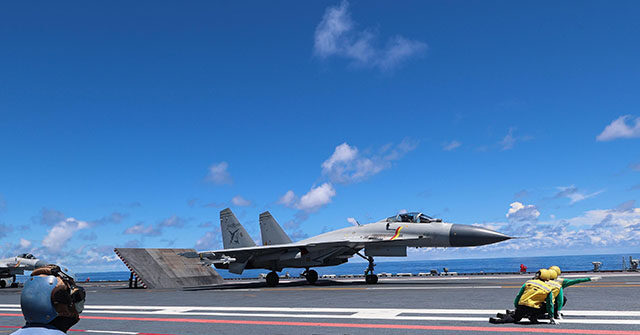The People’s Liberation Army (PLA) of China has been airing a five-part “documentary” on state television called Forging Ahead, coinciding with the 98th anniversary of the PLA’s founding on August 1.
Monday’s episode depicted the PLA performing a “cold start” amphibious invasion of Taiwan — which means switching from a training drill to a full-scale attack.
The South China Morning Post (SCMP) described the episode in menacing terms:
Paratroopers can be seen penetrating enemy lines to guide precision strikes, while infiltrating frogmen seize key infrastructure and amphibious armoured units conduct ship-borne sea transits.
The episode also features unmanned combat formations breaching beachheads after initial firepower suppression, and joint forces executing maritime blockades and area denial operations – all relevant to any amphibious operation across the Taiwan Strait.
The third episode of Forging Ahead depicted one of China’s older J-10 fighters intercepting and defeating an unidentified high-tech stealth fighter, ostensibly demonstrating how extensive coordination and advanced electronic warfare systems would help China’s aging fighter fleet prevail against the state-of-the-art warplanes fielded by Taiwan and the United States.
This installment of the PLA documentary was clearly capitalizing on reports that Pakistan was allegedly able to bring down one of India’s French-made Rafale planes with a Chinese J-10C when those two nations scuffled after a terrorist attack in April.
Although India has not officially confirmed the report, anonymous U.S. officials told Reuters in May that Pakistan managed to shoot down at least one of India’s Rafales, a plane that had never been defeated in battle before. The Pakistanis were careful to use Chinese planes instead of the American-made F-16s in their inventory.
The surprising ability of the technically outclassed J-10C to shoot down a Rafale rattled military analysts around the world, and reportedly made more international customers interested in buying some of China’s inexpensive J-10s for their own air forces.
A follow-up report from Reuters last weekend included new details of the engagement, in which a large number of Pakistani fighters scrambled with the specific goal of bringing down a Rafale. Military experts quoted in the new report said the key factor in the engagement might not have been the J-10C planes, but rather the Chinese-made PL-15 air-to-air missiles they launched, which turned out to have longer effective range than India’s pilots were expecting.
Pakistani officials also said close coordination between the J-10s and airborne radar platforms was a key advantage, allowing Pakistani pilots to target Indian planes without lighting up their own radars. The episode of Forging Ahead that showed a J-10 shooting down a stealth plane also highlighted this capability.
China’s state-run Global Times on Monday praised Forging Ahead for supposedly sending “a clear message that a stronger Chinese military ensures a more peaceful world,” even though the series shows the Chinese military launching a devastating assault on Taiwan.
“In fact, China’s military has become an increasingly important force in maintaining regional and world peace. Nevertheless, some Western media have long labeled China’s military progress as ‘muscle-flexing’ or ‘provocative.’ Such narratives are nothing more than a projection of anxiety over China’s comprehensive rise,” the Global Times sneered.
“China’s military development is not driven by ‘expansion’ or ‘confrontation,’ but by its commitment to safeguarding our national sovereignty, security and development interests as well as a sense of responsibility to uphold international peace and stability,” the article lectured, its authors having apparently forgotten they were just raving about a “documentary” that showed the PLA launching an invasion that would kill hundreds of thousands of civilians and soldiers.
Read the full article here


